A Sacred Festival in Sicily
Sicilian Sagre
Article and photos by Amy
E. Robertson
9/22/2015
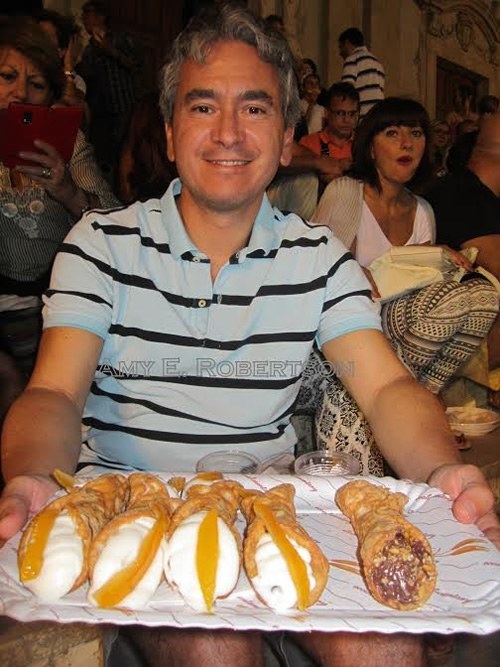
|
|
Luca offers cannoli during
a festival in Gesso, Sicily.
|
My Sicilian husband, Luca, is scandalized
that I eat cannoli during our summer visits to
his native land. Flaky cylinders of crust filled with creamy
sweetened ricotta, this Sicilian specialty is truly more
delicious there than anywhere else I’ve ever tried
(and I try them in every Italian city and Italian-American
neighborhood I visit). But they are rich, heavy, and definitively
not a summer food, according to Luca. And in Sicily, it
is sacrilege not to follow seasonality in food.
Summers are for cold and creamy gelato or
refreshing flavored-ice granite, Luca insists.
But all of my in-laws (and there is an army of them) know
of my predilection for a good cannolo, so my husband’s
aunt was thrilled to inform me that in the village of Gesso,
not far from where we stay, there would be a Sagra del
Cannolo during our visit this August. (Apparently the
people of Gesso were favoring the food’s market appeal
over its unseasonality. I didn’t mind.) Auntie and
I quickly hatched a plan to insist on this as a family outing.
A sagra in Italy is a community
festival held in the main piazza and nearby streets of a
town, dedicated to a local food specialty (or sometimes
to a locally venerated saint). There is some form of entertainment,
and food for sale at very reasonable prices. Sagra (plural: sagre)
comes from the Latin word sacrum, meaning sacred,
which tells you how highly Italians hold their local food
specialties in esteem. In Sicily in the summer, sagre are
held in the evening, when temperatures have dropped and
it is bearable to gather in a piazza rather than on the
beach.
The hilltop town of Gesso was a 45-minute
drive on winding mountain roads from the hillside village
near Messina where we spend our vacations. A medieval village
with a population of 800 isn’t equipped for festival
parking, so we parked well outside of town along the narrow
curvy road and proceeded on foot. Like children after the
Pied Piper, we followed the sound of lively folk music through
the narrow cobblestone streets until they opened up onto
a bustling square. Luca took a place in the food line while
the rest of our family pack found a spot to sit on the stairs
of the town church, which formed a grandstand of sorts to
watch the performances in the square.
A procession of three Sicilian horse-drawn
carts, resplendent with detailed painting and driven by
swarthy men wearing white shirts, red neckerchiefs, and
black coppola hats, paraded through the piazza. A girl who
didn’t look more than 10 years old sang tunes in incomprehensible
Sicilian, accompanied by men on guitar and accordion. The
town had organized a set menu for their food, which included
a cheese and tomato panino, a glass of red wine,
one of their famed cannoli, and second cup of wine
(this time sweet golden Zibibbo), all for just five euros.
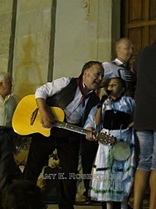
|
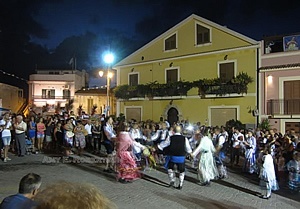
|
|
Folk musicians and
folk dance during the festival.
|
As we munched, a traditional dance group
performed in the square, sashaying to folk music with tambourines.
The sandwich was nothing special, but the cannolo… Crunchy,
creamy, fresh, and sweet. It was glorious.
It was a small event, a community festival
in a hilltop village, but I realized that it was probably
the best way to visit that tiny town. All the charm and
authenticity that tourists ever look for, without any other
tourists in sight. The only language besides Italian that
I heard was Sicilian. Villages throughout Europe (and in
many places around the globe) can be quiet and closed to
outsiders when you travel through them on an ordinary day.
Visit them on festival day, however, and you have the chance
to see its heart as it beats.
I was hooked. I insisted that we next
attend the Feste Aragonese (Aragon Festival) in
Montalbano Elicona, another village not far from Messina
that was named Borgo dei Borghi (Village of Villages)
for 2015. (Borgo dei Borghi is a national competition
to identify the most beautiful towns and villages of Italy
- Sicily is two for two, with the town of Gangi winning
the competition in its launch year of 2014.) After watching
a reenactment of the arrival of King Frederick of Aragon
to Montalbano in the early 14th century, we wandered the
medieval streets of the village center where period-dressed
people demonstrated habits of the time, from archery and
sword fighting to stockades and spiced wine.
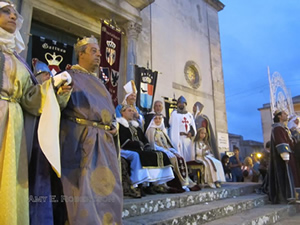
|
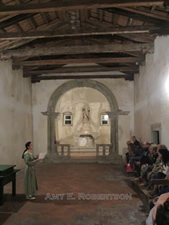
|
|
The
reenactment of the arrival of King Frederick II.
|
A woman in a medieval
peasant dress explains the history of the chapel.
|
A few days later Luca and I headed to
the village of Savoca for an arts festival. At my request
we’d made a pilgrimage to the town some 15 years earlier:
its biggest claim to fame being that it was the location
for the scene from The Godfather when Michael Corleone asks
for Apollonia’s hand in marriage. During this visit
we discovered that there is so much more to see than Bar
Vitelli of Godfather fame. Climbing up and down the warren
of streets of the hilltop village, we found something new
around each corner: an artist exhibiting paintings, a woman
selling homemade crafts, a jazz trio, a photography exhibit,
a lone guitarist, a winery offering tastings, an author
selling her books. The churches and museums were open until
midnight, and a town that can be dead in the middle of a
summer day (as it was on our previous visit) blazed with
life and art and music.
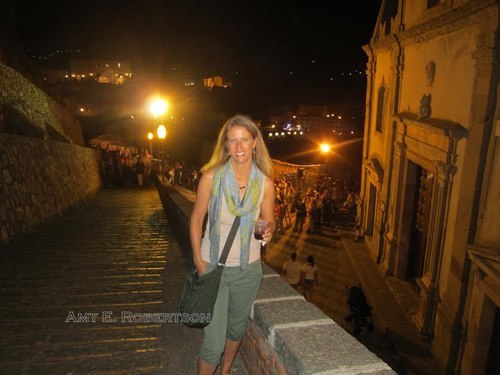
|
|
The author in Savoca.
|
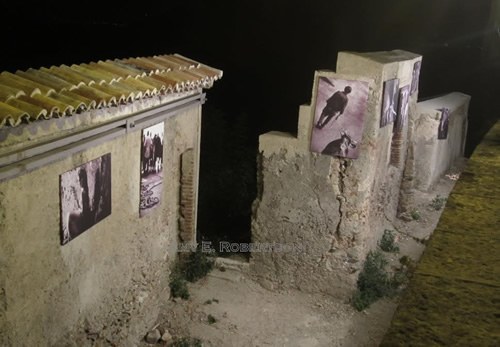
|
|
A photography exhibit adorns
the ruins of an old wall.
|
Small-town festivals are designed by
and for the local communities, and can be hard to track
down for itinerant visitors. Their homegrown appeal can
also have its downside: performances and food can be hit
or miss, and locals might have a different idea of what
they want to share than what you had hoped to experience.
(In addition to folklore music and dance, in Gesso we were
also treated to a performance by a local belly-dancing group.
Not exactly what we’d traveled from our current home
in the Middle East to see.)
But overall, the festivals — and towns
— were fantastic. In many of the places I’ve traveled
to — Italy, Lebanon, Spain, South America — I’ve
been in villages that are quaint but eerily quiet. You wander
alone and see more closed doors than sights, as they aren’t
tourist destinations. The festivals enabled us to experience
villages that were off the beaten path at a time that doors
were thrown open and town squares brimmed with life. And
at the small-town festivals, I found myself rubbing shoulders
with others that came from neighboring villages to enjoy
the spectacle, rather than crowds of fellow foreigners.
It wasn’t always easy to find festival details or
directions, but every effort was well worth it. I knew it
the moment I tasted that celebrated cannolo.
|
How to Find Community
Events in Sicily
Online
In Sicily I was able to track
down limited information online for community events,
and only in Italian. If traveling to Italy or Sicily,
two online resources for sagre and other
similar events are:
www.siciliainfesta.com – Fairly
complete guide to events in Sicily year round,
searchable by province.
www.giraitalia.it – This
site includes events across Italy, searchable by
region and month. Dates don’t tend to vary
much from year to year.
Around town
The best source of information
was the local paper, but finding info required
a daily scouring. Sometimes we saw signs around
Messina announcing events in the surrounding community.
If you don’t read the local language, ask
at your hotel for help.
|
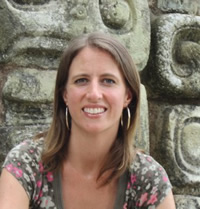
|
Amy E. Robertson has written many articles for TransitionsAbroad.com as Connected Traveler Contributing Editor.
She is the author of numerous publications for Moon Handbooks. Her writing has been published on NPR, Vice MUNCHIES, Budget Travel, Delta Sky, National Geographic Traveler, Wall Street Journal, Christian Science Monitor and Travel + Leisure, among others.
Amy has lived in six countries and traveled in more than 60.
Her volunteer experiences include building houses in Washington State and Honduras, monitoring presidential elections in Ecuador, working with youth on social documentaries in Bolivia, and serving lunch at soup kitchens in Seattle and Beirut.
Amy has a background in international development and nonprofit management and has worked in both the private and nonprofit sectors.
|
|
